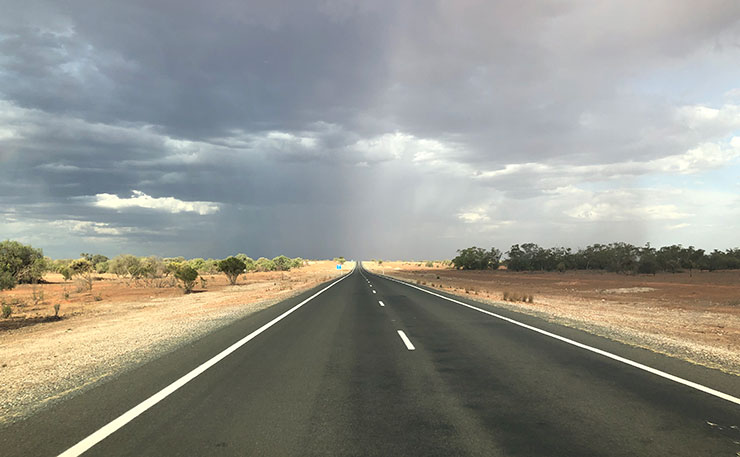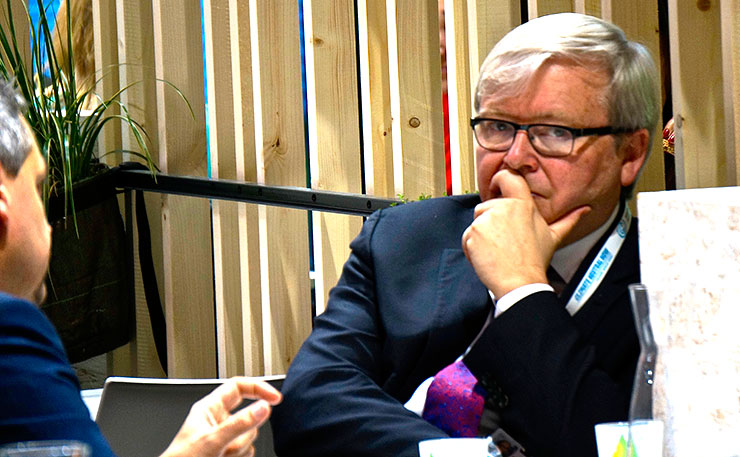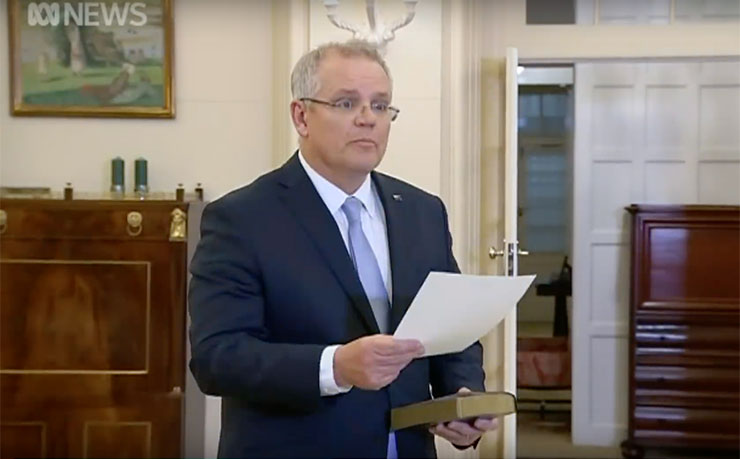What’s this obsession with ‘national security’? Let’s talk about the climate emergency and the complicity of the powerful, writes Dr Richard Hil.
“It is the Australian Government’s most important responsibility to do everything possible to keep Australians safe and to maintain our way of life, our values and our freedom.” – Australian Liberal Party
Given the unprecedented floods in North Queensland, a crippling drought across vast tracts of the continent, record-breaking heatwaves, and the Tasmanian wild fires, is it time for a renewed public conversation about national security? The climate emergency surely demands such, especially since Australia is the world’s leading exporter of coal and one of the biggest per capita emitters of greenhouse gases.
We are facing a deep and enduring crisis of political legitimacy in which governments in the US, Brazil, Australia and elsewhere are pursuing policies out-of-step with popular demands for change. A well-organised and assertive grassroots campaign is needed, not to plead for change from governments, but rather to compel the powerful into action, to hold them to account in order to deal with the threats that are before us.
A hot night in Noona
Maxed-out air-conditioners are doing it tough in many parts of Australia. And perhaps nowhere more so, than in the tiny hamlet of Noona in the far west of NSW, 670 kilometres or so west of Sydney, where the night-time temperature on 16 January 2019 refused to drop below a record-busting 35.9C.
That’s pretty hot, right? Some of us are more familiar with Fahrenheit as a temperature gauge which means that Noona sweltered under a staggering 96.6F. That’s super-hot during daylight hours never mind the nocturne. In fact, on the same day the daylight temperature in Noona peaked at over 48C. Make that 118F.
Let’s put that into some sort of context. In England – yes, the land of the long grey drizzle – if and when summer temperatures reach anywhere approaching 90F, the country goes into meltdown – literally in some cases. It’s when we see the stringy vests, blotchy white legs and beetroot faces. The tabloids blather on about Indian summers and the like. So just imagine if the Poms had to endure 95.9F at night? And you think they whinge now?
Yes, Australia is the driest, hottest continent on the planet and, yes, we get heatwaves during the summer. There’s nothing new about that. But as a result of the climate emergency, we are now experiencing more extreme heatwaves, so much so that the Bureau of Meteorology has added a new colour code to its temperature charts.

On the day of the big heat – or what The Guardian dubbed the “great Australian heatwave” – Noona was turned into a ghost hamlet as residents, many of them elderly, sought relief in any way they could. Nearby, there were stories of roads melting and cars overheating. Regular health warnings were issued by the Bureau of Meteorology via ABC regional radio. Panic was in the air.
Noona was one of many record-busting places that sweltered under a dome of extreme heat that lasted for several days, this on top of prolonged drought conditions that have ravaged many parts of Queensland and NSW.
Climate emergency denialists will, of course, point to previous high temperatures not all that dissimilar to what was experienced last week. And they’d be right: many parts of Australia have, in earlier times, experienced episodes of extreme weather. But it’s not the one-off events that should so bother us (although they are deeply alarming), but rather the patterns and trends clearly showing a consistent trajectory of record-breaking temperatures over the past decade. Just as one record is broken, another is smashed the following year, or in the same year. There have been over a dozen records set so far this year, and we’re only in February.
What does a cursory examination of all these trends and patterns tell us? We have greatly increased our use of fossil fuels since the 1950s which has released vast quantities of CO2 into the atmosphere, adding to the greenhouse effect. Consequently, atmospheric temperatures have risen sharply which has led to the melting of polar-ice-caps and rising sea levels. These altered climatic conditions have produced more and more extreme weather events in the form of heatwaves, droughts, storms, floods, wild fires, etc.
What’s clear then, according to all the available science, and what the people of Noona and elsewhere need to know, is that heatwaves are getting more intense and lasting longer. This poses significant health, environmental and social risks. Let’s put it this way, if you happened to find yourself in Noona on that fateful day without an air conditioner or fan then you’d need more than shade and industrial strength anti-perspirant to cope.
As noted on the BBC News website, at temperatures around 40C: “ …heat exhaustion is likely – and above 41C, the body starts to shut down. Chemical processes start to be affected, the cells inside the body deteriorate and there is a risk of multiple organ failure. The body cannot even sweat at this point because blood flow to the skin stops, making it feel cold and clammy”, not surprising really, given that 118 degrees is way over the body’s own temperature of 98.6F. Something has to give.
Those most at risk are the very young, the elderly, those with acute health conditions, and the poor and marginalised who simply can’t afford air-conditioning etc. The financial costs in terms of damage to agriculture, infrastructure and so forth are incalculable. As a result of drought conditions and prolonged high temperatures the price of bread has already shot up thanks to increased grain costs, and fruit and vegetables prices have also headed north.
Similar rises are likely to occur with meat produce as farmers struggle to protect their stock from heat stress. Dozens of wild horses have already expired in the Northern Territory and thousands of Fruit Bats have experienced the same fate, suggesting that should current conditions continue, the impact on farm animals (and pets) will be serious.
Heatwaves are of course only one symptom of anthropogenic climate change. To be sure, there are many other things to worry about such as the destruction of ecosystems and loss of biodiversity. These are interconnected problems generated by GHG emissions and many other contributory factors. Yet despite all the global agreements, the targets, the trading schemes, the dire warnings, the unprecedented scientific consensus, we are emitting more CO2 gases than ever and the level of carbon in the atmosphere is at record levels. Meanwhile, fossil fuel extraction proceeds at a pace, as governments vacillate, deny or deceive, or all of these at once. There is talk of impending catastrophe and even extinction.
The pace of climate change has stunned scientists who now warn that we are on the precipice of disaster, if current levels of carbon emissions are not checked – and soon.
It’s time
To avoid what Australian environmental activist, Aidan Ricketts, calls “the great catastrophe”, or what Professor Noam Chomsky describes as “an existential threat to organised human existence”, we need an organised and assertive social movement that compels the powerful to act on the climate emergency. They should be given no choice.
The climate conferences in Copenhagen, Paris and Katowice have made some headway, although the agreements struck depend on good faith rather than binding commitments – a risky venture when corporate self-interest and denialism abound. The environmental justice movement, perhaps the biggest social movement in human history, has also made great inroads in terms of mounting a powerful case against fossil fuel extraction as well as calling for the rapid transition to clean energy and energy democracy.

People around the world want urgent action on climate change, and they’re demanding radical change. Governments are being held to account for either dodging the necessary policy decisions to reduce emissions or have been forced into taking action by the courts, as occurred recently in Holland. Indeed, legal action taken by young people in the US and environmental groups across Europe indicate the determined nature of opposition to the current orientations of many governments and fossil fuel corporations.
Radical and direct nonviolent action, as advocated by groups like Extinction Rebellion, have also played a key part in raising awareness about the imminent threat posed by the climate emergency and targeting those responsible.
A collective sense of urgency has given rise to a new politics based on much more assertive activist agendas that are finding expression in grassroots movements. This is bottom-up, community-based activism uncompromising in its aims and unimpressed with the nebulous promises of political elites, many of whom find themselves tethered to the interests to powerful corporate entities.
The anti-extractivist movement has also helped to generate a rapid rise in clean energy investments that have diminished the market value of coal and which threaten to do the same to other fossil fuel industries. Battery storage, hydro plants, solar and wind farms, and hydrogen are all examples of alternatives to fossil fuels. Not that investment in fossil fuels has disappeared. Far from it. Hundreds of coal-fired power stations are still under construction around the world, and new mines have been proposed in Australia and elsewhere, despite enormous public opposition.
But is public opposition to impending climate carnage enough? No, is the short answer, because time is against us. Estimates vary as to how much time we have before runaway climate change occurs, if it hasn’t already. The IPCC has said we have a 12-year window before it is firmly shut, others suggest a much shorter timeframe. Either way, there’s a lot to worry about.
Our national-global (in)security
One of the most important obligations of any government is to ensure the security of its people. All governments take this responsibility seriously, albeit in different ways and with varying degrees of emphasis.
The Liberal Party of Australia is clear about its responsibilities when it comes to national security. According to its policy position set out on its website, the Party aims to disrupt terror plots, pass tougher anti-terrorist laws, boost funding for security agencies, fight terrorists abroad, cancel citizenship for terrorism conduct, crack down on paedophiles, stop asylum seeker boats, and tackle illegal drugs, illegal firearms and gang-related activities.
Despite the fact that there have been only three jihadist terrorism-related deaths in Australia, the federal government and its agencies appear obsessed with such threats. To be sure, threats do exist and attacks have indeed been prevented, but if the concern was over how to prevent avoidable deaths then, as Melbourne-based scientist Gideon Polya makes clear, the state would devote far more resources to the prevention of deaths from adverse hospital events, road accidents, obesity, smoking and alcohol, carbon burning pollution, suicides, opiate drug-related deaths and homicides which, when taken together, run into the hundreds of thousands.
The government’s website, Australian National Security, is almost entirely devoted to terrorism prevention. There is no mention in either the Liberal Party’s plan or the National Security website of the very real threat posed by the climate emergency, perhaps because this is regarded as beyond the remit of criminal justice oversight.
Given that the IPCC, CSIRO, BOM, NASA and many other credible science agencies have noted dramatic increases in the number of extreme weather events over the past decade, with more to come, this omission is breathtaking. To identify climate change as a risk to people would, however, imply that the government itself, through its various carbon-generating policies, is partly culpable. At the very least, this would suggest gross negligence in terms of the deliberate failure of government to exercise due diligence when it comes to the security of its own people.
Reframing how we think about climate policy
So, when it comes to climate change, what sorts of security considerations are we talking about? It’s not the first time this question has been raised. Indeed, the US military, various security agencies, insurance companies, risk managers, actuarialists, academics and investors have all turned their minds to such matters. It’s not only that housing and physical infrastructure will be at risk from rising waters, storms and the rest, but some towns, cities and regional areas may become unliveable. Food shortages will lead to higher prices and greater competition, with some nightmare scenarios of survivalist communities seeking to protect their food supplies. Population movements and economic instability will likely result in increased social unrest.
This scenario has been spelt out in many publications, and as mentioned above, the relevant security agencies are keenly aware of them. Spikes will be seen in death rates and illnesses owing to extreme weather events, thereby putting even more pressure on already overstretched health services. The psychological stressors arising from all this will be widespread, impacting on communities and neighbourhoods.
Little of this sense of impending crisis, and the enormity and urgency of what needs to be done, can be found in the government’s policy statements or in its 2017 Discussion Parser on climate change polices. Instead, we are blithely told that, “The Australian Government is committed to addressing climate change while at that same time ensuring we maintain energy security and affordability. The Government recognises that in reducing emissions and meeting our international commitments there are economic impacts to be balanced… Climate change is a global issue that requires international action.”
What follows are pages and pages of suggested and actual policies that focus on emissions reduction initiatives across business and industries, farming and agriculture, local government and communities, and individuals and households. These policies constitute a sort of practical guide or tool kit for reducing emissions rather than a wholesale attempt to respond to what are emergency conditions, or indeed making the commitment to urgently shift from old to new energy sources.

We have to remember that the Coalition government has no coherent energy policy, but nonetheless insists on coal as part of the “energy mix” into the foreseeable future. Numerous climate deniers sit on the government benches and the Coalition’s leadership finds itself constantly at the mercy of these ideologues – this despite the fact that poll after poll show that the overwhelming majority of the Australian pubic want urgent action on climate change.
The science community and environmental organisations argue for a wholesale and rapid transition to clean energy if the worst impacts of climate change are to be avoided. In addition to the obduracy of government, these groups have to contend with what, in effect, is the muzzling of climate emergency discourse when it comes to extreme weather events. This self-censorship is demonstrated in mainstream news reports about floods, heatwaves and bushfires where, more often than not, strenuous efforts are made to avoid any reference to climate change for fear of being accused of “politicising” tragedies.
The gulf that exists between citizens and politicians and corporate leaders when it comes to action on climate change is deepening. And it’s deepening because of growing concern over extreme weather events, like the heatwaves and floods experienced across the nation in early 2019. It is also a reflection of the growing chasm between political elites, their allies and citizens who have lost confidence in democratic systems, political parties and even democracy itself.
Inaction on economic inequality and climate change are key drivers of such disillusionment, as is discontent over the rather insular and self-promoting culture that exists among the political elites. It has become glaringly obvious that action on climate change will only come from sustained and organised action from below. This is occurring with impressive effectiveness around the globe despite countervailing forces. Certainly, the 2018 IPCC report has added weight to calls for such action, with the window of opportunity closing fast.
Taking rapid and radical action on climate change is not simply the ‘great moral challenge of our time’, as Kevin Rudd once proclaimed, it is imperative for planetary survival. The depths of the crisis have to be clearly articulated and responsibility sheeted home to those powerful elites responsible for the current situation.
We may also need to change our language and seek to locate inaction on climate change within the arena of criminal justice, whereby political leaders and corporate chiefs are held to account for actions contributing to rising global GHG emissions.
The fact that a green light has been given by federal and state governments to the Adani mine in far North Queensland or to the mines in NSW’s Hunter Valley is not merely reckless policy. It constitutes a direct and wilful assault on the democratic will of the people, and on the planet as a whole. It’s a form of policy violence that cannot and should not be ignored.
One only has to think about the current Australian PM entering parliament holding up a lump of coal to understand the depths of cynicism toward what is an unprecedented existential crisis. It’s an act of contempt directed at all of us.
Donate To New Matilda
New Matilda is a small, independent media outlet. We survive through reader contributions, and never losing a lawsuit. If you got something from this article, giving something back helps us to continue speaking truth to power. Every little bit counts.




